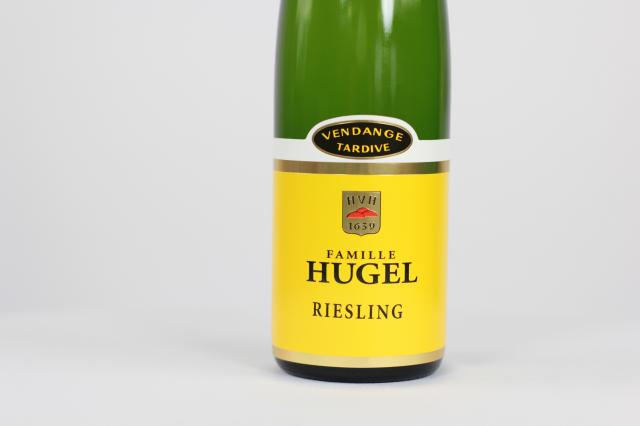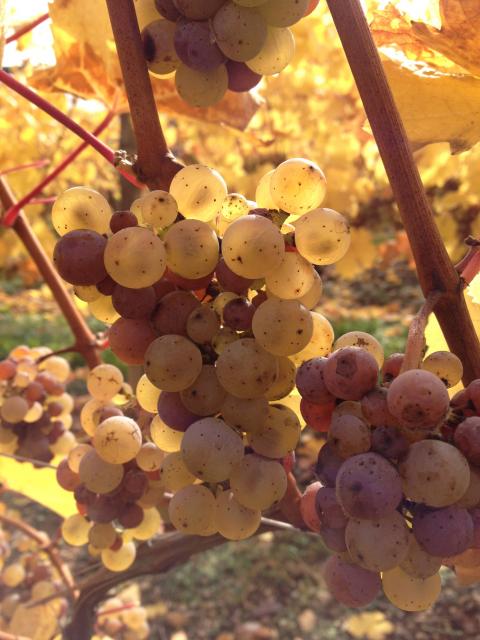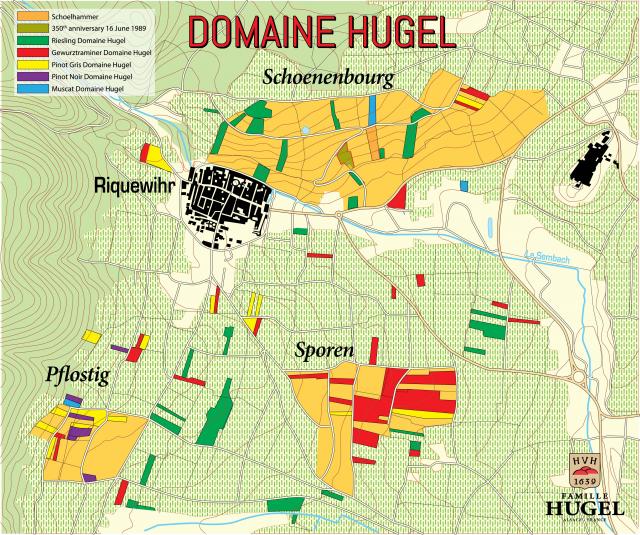Famille Hugel
Riesling VENDANGE TARDIVE 2011
Great specialty for several generations of the Hugel family, who drafted the law on late harvest.
Wine with great power and longevity to taste religiously by itself during a special occasion.
Wine with great power and longevity to taste religiously by itself during a special occasion.
Specifications
Alcohol content : 12.8° % vol.
Residual Sugar : 63 g/l
Tartaric acidity : 6.35 g/l
pH : 3.39
Age of vines : 30 years old
Yield : 28 hl/ha hL/ha
Presentation
Quick View
These wines made from overripe grapes are picked well after the classic vintage and in the greatest years only. The action of noble rot (botrytis cinerea) gives them an almost unlimited ability to age. They are part of the elite of the greatest wines in France.
The vintage
The winter of 2010 was particularly harsh, with more than 30 days below zero, and temperatures dropped as far as -17°C. Budburst on 8 April was early, but flowering which began on 10 June took almost 3 weeks to finish due to cool temperatures. July was exceptionally hot and sunny, before cold, damp and rainy weather set in throughout August and into September. Ideal weather conditions returned on 11 September, with not a drop of rain for 6 weeks. Our harvest began on 27 September and ended on 26 October. Maturity reached record levels, the highest for 50 years, with good acidity, similar to 1996. Crop size was 30% below average, and even lower for Gewurztraminer.
Superb wines with magnificent balance, purity and fruit. 2010 is a great classic vintage, with good ageing potential.
Superb wines with magnificent balance, purity and fruit. 2010 is a great classic vintage, with good ageing potential.
In the vineyard
Produced from over-ripened grapes in a selection of the oldest plots of the Hugel estate in the heart of the grand cru Schoenenbourg. This fantastic historical terroir has been almost exclusively devoted to Riesling for centuries.
Keuper, marl, dolomite and gypsum, rich in fertilising agents, overlaid with fine layers of quaternary siliceous gravel, Vosges sandstone and Muschelkalk, with at its eastern extremity outcrops of Lias marl limestones.
Harvest date : 12 Oct. 2010 Potential alcohol : 15.0°
Keuper, marl, dolomite and gypsum, rich in fertilising agents, overlaid with fine layers of quaternary siliceous gravel, Vosges sandstone and Muschelkalk, with at its eastern extremity outcrops of Lias marl limestones.
Harvest date : 12 Oct. 2010 Potential alcohol : 15.0°
Winemaking
The grapes are taken in small tubs to the presses, which are filled by gravity, without any pumping or other mechanical intervention.
After pressing, the must is decanted for a few hours, then fermented in temperature-controlled barrels or vats (at 18 to 24°C). The wine is racked just once, before natural clarification during the course of the winter. The following spring, the wine is lightly filtered just before bottling, and the bottles are then aged extensively in our cellars until released for sale.
The whole production of this wine is closed with DIAM the cork without the risk of cork taint.
After pressing, the must is decanted for a few hours, then fermented in temperature-controlled barrels or vats (at 18 to 24°C). The wine is racked just once, before natural clarification during the course of the winter. The following spring, the wine is lightly filtered just before bottling, and the bottles are then aged extensively in our cellars until released for sale.
The whole production of this wine is closed with DIAM the cork without the risk of cork taint.
Presentation
Varietal
Riesling : 100%
Specifications
Alcohol content : : 12.8° % vol.
Residual Sugar : : 63 g/l
Tartaric acidity : : 6.35 g/l
pH : : 3.39
Age of vines : : 30 years old
Yield : : 28 hl/ha hL/ha
Advice
Video
Tasting notes by Serge Dubs, World's Best Sommelier 1989
It has a superbly intense, dense and brilliant robe with crystalline and silver highlights. A well-stated straw-yellow combined with a range of green shades: pale green, pistachio, lime tree, young shoots of primrose in spring time; the tight legs are thick, smooth sophisticated.
The aroma also has the same sense of generosity, ranging from the expressive clear, sharp and pure to the powerful, aromatic, floral and intense bouquet of the grapes which were harvested just as the hint that perfect level of over-ripeness yet always retaining the great class of a Riesling. The bouquet is very harmonious, soft and smooth with a nice touch of freshness. Acacia honey, preserved pears, kumquat, citron, bergamot, hawthorn and acacia blossom and the slight mineral hint that is so central to the charm of this grape variety which remains unique and rare, especially as a late harvest.
On the palate it is a marvel of taste and flavours structured over a wonderfully acidic, fresh, refined and joyful background. It is a sweet, fruity, generous, smooth and sophisticated wine with a crystalline purity to its flavour and after-taste.
The harmony and balance of this Late Harvest Riesling is exemplary.
Best served immediately to make the most of its perfection, delicacy and sophistication; but perfect if served between 5 and 15 years from now.
As a young wine it is best appreciated as an aperitif with foie gras or desserts that are not too sweet.
In 10 to 20 years it will be thick, creamy, soft and mineral with a less stated sugar-content, and it will be perfect in association with oven-baked sea and freshwater fish, or in cream sauces, with black or white truffles, poultry, capon, pheasant or partridge.
The aroma also has the same sense of generosity, ranging from the expressive clear, sharp and pure to the powerful, aromatic, floral and intense bouquet of the grapes which were harvested just as the hint that perfect level of over-ripeness yet always retaining the great class of a Riesling. The bouquet is very harmonious, soft and smooth with a nice touch of freshness. Acacia honey, preserved pears, kumquat, citron, bergamot, hawthorn and acacia blossom and the slight mineral hint that is so central to the charm of this grape variety which remains unique and rare, especially as a late harvest.
On the palate it is a marvel of taste and flavours structured over a wonderfully acidic, fresh, refined and joyful background. It is a sweet, fruity, generous, smooth and sophisticated wine with a crystalline purity to its flavour and after-taste.
The harmony and balance of this Late Harvest Riesling is exemplary.
Best served immediately to make the most of its perfection, delicacy and sophistication; but perfect if served between 5 and 15 years from now.
As a young wine it is best appreciated as an aperitif with foie gras or desserts that are not too sweet.
In 10 to 20 years it will be thick, creamy, soft and mineral with a less stated sugar-content, and it will be perfect in association with oven-baked sea and freshwater fish, or in cream sauces, with black or white truffles, poultry, capon, pheasant or partridge.




